The Showstoppers – Various Artists
Featuring The Mike Sammes Singers, Cleo Laine, and George Chakiris of West Side Story fame.
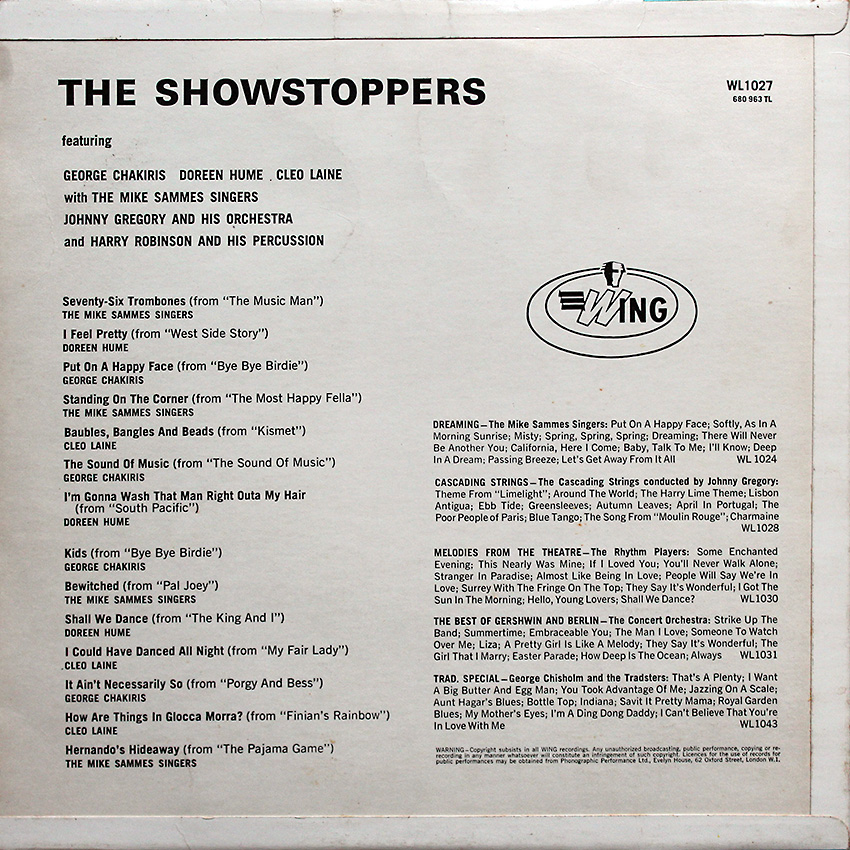
Label: Wing WL 1027
Featuring The Mike Sammes Singers, Cleo Laine, and George Chakiris of West Side Story fame.

Label: Wing WL 1027
Latin rhythms – fast, slow, brash, or moody – have long been firmly established favourites on this side of the Atlantic Ocean. I don’t know what this extra “something” is that these rhythms possess, but they’ve always intrigued me, and almost everyone who hears them.
The most popular purveyor of “class” Latin music is CHAQUITO: when the Latin craze first hit England some years ago, it was CHAQUITO who scooped the market in no uncertain manner. It was CHAQUITO’s fresh and fascinating arranging that was copied by many other would-be Latin bandleaders. It was CHAQUITO who caused a large American booking agency to spend much time, trouble, and money searching the whole of South America for the band, to book them into North America.
As with most things, CHAQUITO has moved along the musical tread-mill, keeping a close watch on the latest fads and fancies – and he is still the highly successful, big-selling Latin Man, this time with his unique QUEDO BRASS sound.
Hear it. Not raucous, not blasting, but smoothly different, exceedingly attractive – and highly rhythmic.
You’ve gotta dance!
Or listen …
The price is the same!
Here, on this special album, are twelve brilliant CHAQUITO and the QUEDO BRASS, numbers, including many of the favourite “standard” tunes throughout the years.
You’re going to enjoy this – and all the other CHAQUITO albums!
Jack Baverstock

Label: Fontana BIG 319-L
An assortment of delectable dances of Old Vienna, in original scoring.
No dance music rivals that of old Vienna in combining the most ravishing, open-hearted popular appeal with the artistry and permanence of the finest musical craft. And no other dance music is so much of a performer’s as well as composer’s show. In the tradition of the history-making Vienna waltz composers who – in their small bands with violin bow in hand, here Willi Boskovsky, the celebrated violin soloist and leader of the Vienna Philharmonic Orchestra and a group of first desk men of this famous orchestra, address themselves nostalgically and affectionately to a bouquet of exquisite, tender and boisterous old Vienna dance music. Included are great classic composers like Haydn and Schubert to whom dances represented an occasional music and relaxation from more serious efforts; inspired specialists in the dance like Lawler and the elder Strauss; and forgotten composers of remarkable little pieces like Mayer and Stelzmuller, all revealing their musical kinship in this rapturous recreation of the winsome Viennese dance spirit in its lovely flowering.
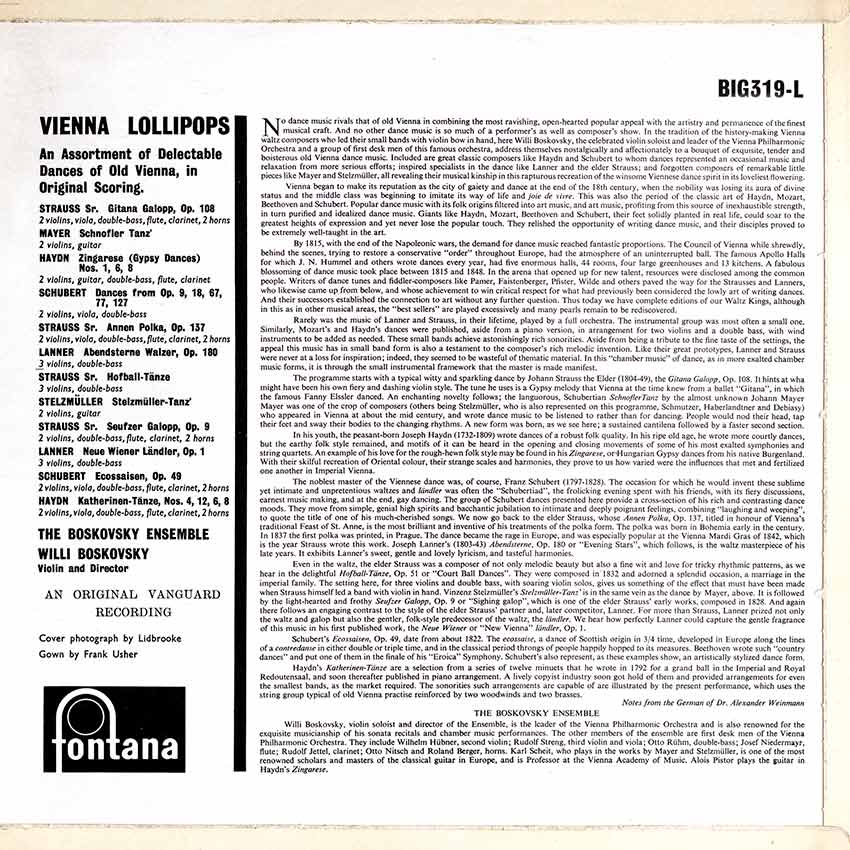
Label: Fontana BIG 319-L
The scores of the ‘Unfinished’ Symphony, as well as that of ‘Rosamunde’ had lain undiscovered for well over fifty years in dusty cupboards, before they were available to the world of music. The Viennese conductor Johann Herbeck discovered the ‘Unfinished’ in 1865 in Graz at a house of a former friend of Schubert’s. He copied it and introduced it for the first time in Vienna in December of that year – 37 years after the death of Schubert. In composing Eine Kleine Nachtmusik, Mozart gave to the world a precious jewel which has lost none of its radiant beauty. Eine Kleine Nachtmusik is one of the most famous examples of the lighthearted serenade music which was so characteristic of the eighteenth century. The work is loved by all; by music scholars as well as by those who only occasionally listen to classical music. To a lot of people it was just hearing Eine Kleine Nachtmusik, which interested them in classical music.
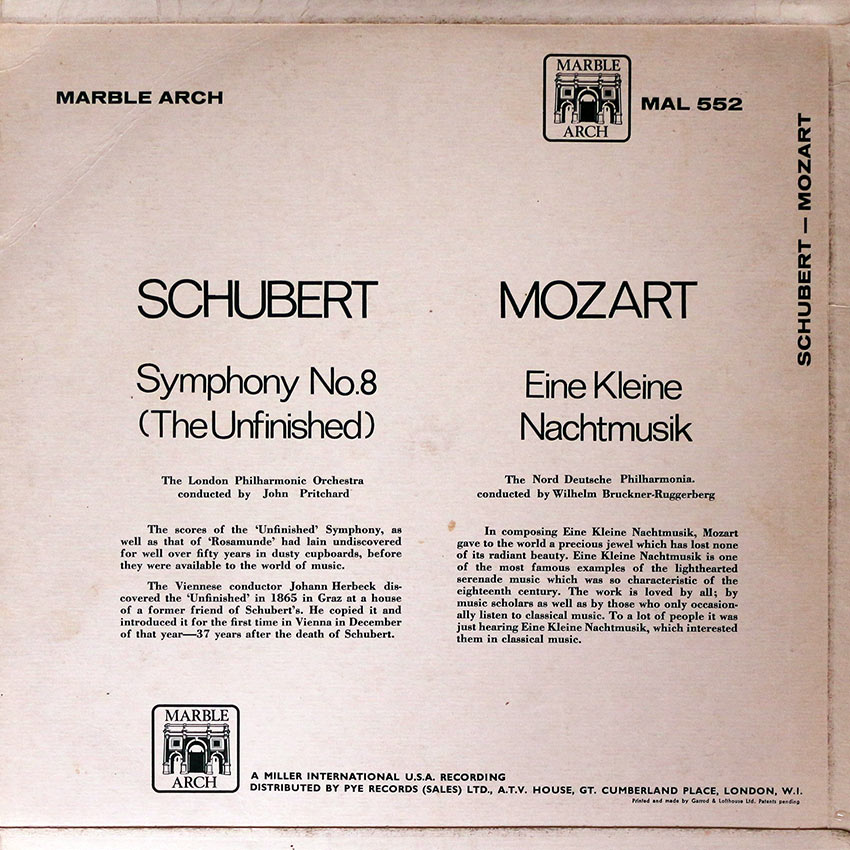
Label: Marble Arch MAL 552
The belly dance causes frenzy and disturbance. To the primitive it was not just sensation and pleasure but life, and unity with nature. In Vegno (sic), Africa it means fertility and the dance boils to ecstatic moments. There are other styles and meanings in Africa: from Loango to Zanzibar. The Sheik’s Men many of the songs are traditional, familiar (The Song The Belly Dancer you may recognise as the Song of India.) There are new songs, authentic songs.
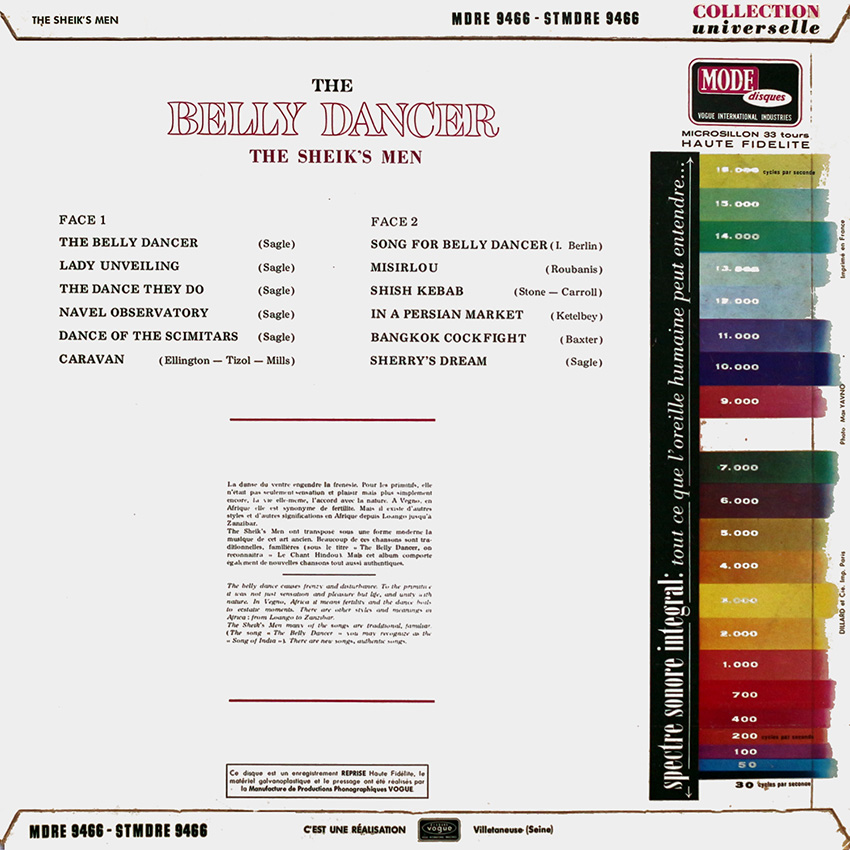
Label: Mode Disques MDRE 9466 (mono) STMDRE 9466 (stereo)
Xavier Cugat was married five times. What we might describe as eternal hope over experience. He also lived to 90 years of age so it clearly agreed with him.
THE MAN AND HIS MUSIC
For thirty years Xavier Cugat has remained the world-wide king of the Latin-American beat. It is almost entirely due to him that we have received the thrilling tempo of the Afro-Cuban world in our own continent. In the early 1930’s, in a historic radio series in the States “Let’s Dance” which also featured the swinging Benny Goodman, Cugat swept the country with the rumba, a rumba that was adapted by him from the complicated Cuban steps to something more suited to the American world.
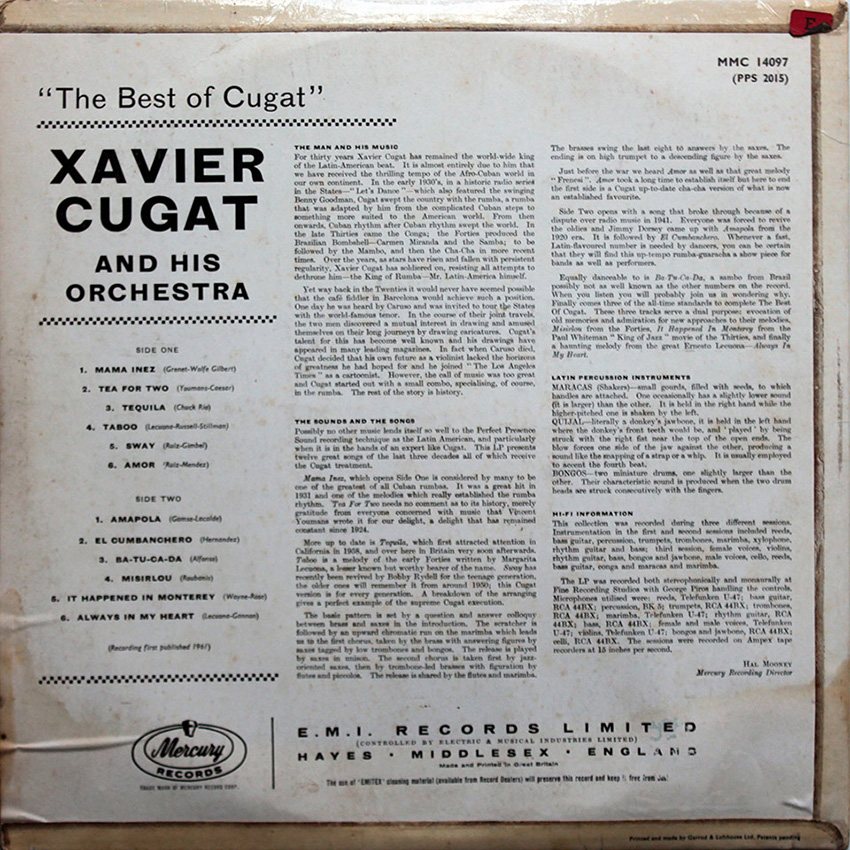
Label: Mercury Records MMC 14097
George Shearing had quite a life, successful in many ways despite being born blind. An Englishman, he later became a US citizen but retired in part back in Gloucestershire, UK in his later years. This album is typical of many from this period, very relaxing to listen to, to look at and to enjoy. George released several “Latino” records based mainly on sambas, cha-chas and boleros.
“Authentic” seldom describes Latin rhythms played by a non-Latin musician. But it has correctly applied to George Shearing’s stylings in three previous hit Latin albums for Capitol, and so it does here. George’s is a sunny, danceable, now-famous brand of Latin that he applies not only to these exciting mambos and cha-chas, but to the subtle, insinuating boleros, as well.
“These boleros,’ George explains, “bear no resemblance to the famed Ravel composition. The bolero rhythm we play here is the Latin ballad tempo. Latin with mild seasoning, if you like, it’s distinctly an Afro-Cuban style — as distinctly as Armando’s.
The bongo and conga playing of Armando Peraza is indeed distinctly Afro-Cuban, and it must be described with such contradictions as “controlled” and “frenzied,’ Armando has served as the percussion mainstay in each of the Shearing Latin albums to date, and joining him as important additions to the Quintet in each of these numbers are several other Latin percussionists and a flutist.
The flute, by the way, adds an exciting first-time element to the Shearing sound — new scope to the Quintet’s Latin mood. And “Mood Latino” promises to add a new scope to your enjoyment of Latin music. There’s enough variation in tempo — from the smooth to the tempestuous — to satisfy any listener’s ear or dancer’s feet. There’s an even mixture of standards in Latin translation and fiery Latin originals. There’s … but to say more would spoil the mood you’ll soon be in.
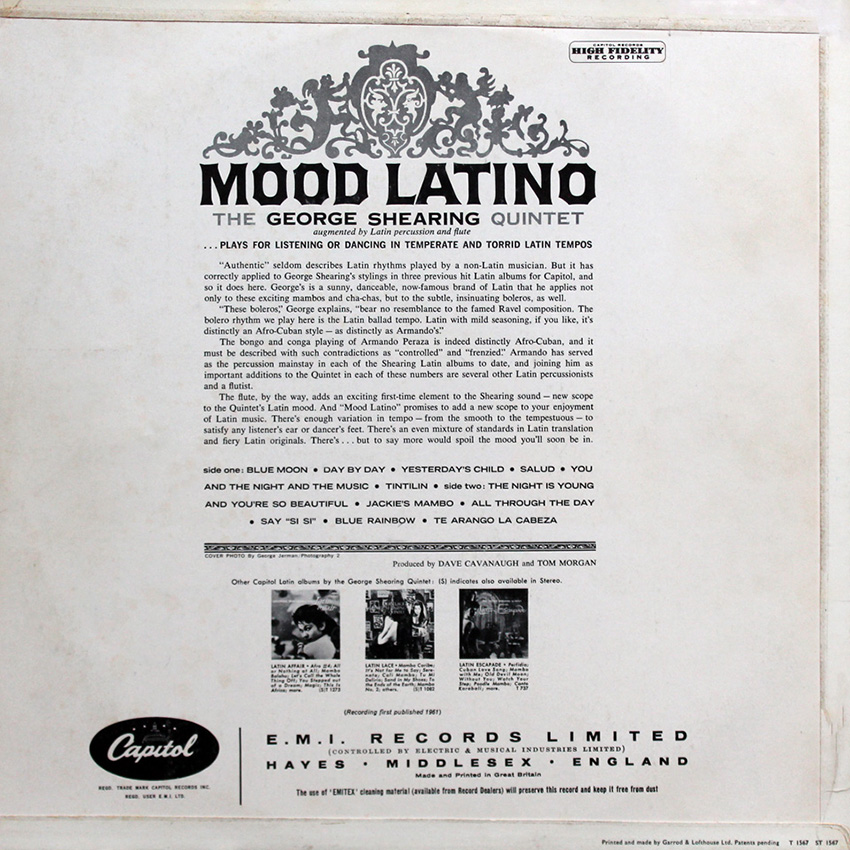
Label: Capital T1567